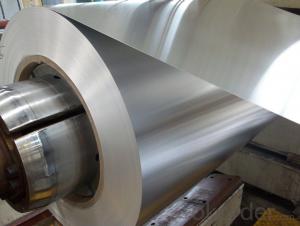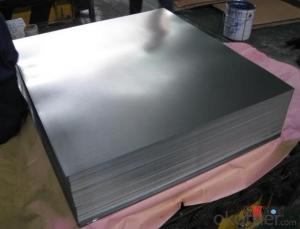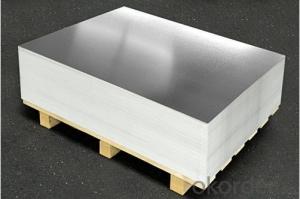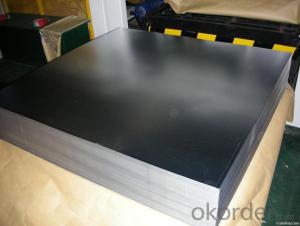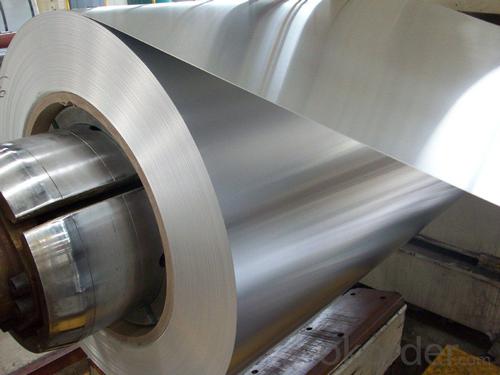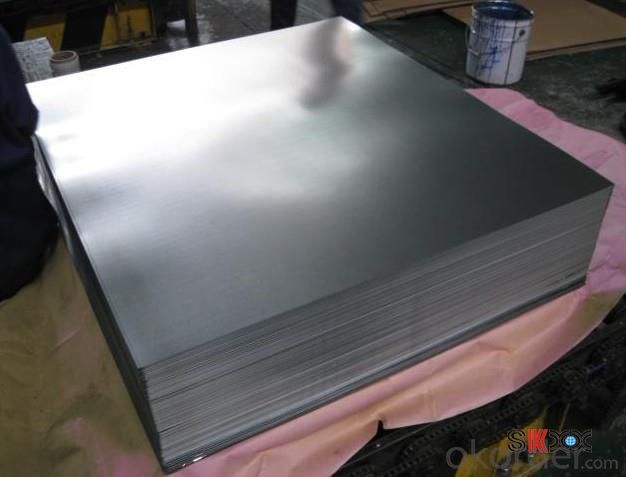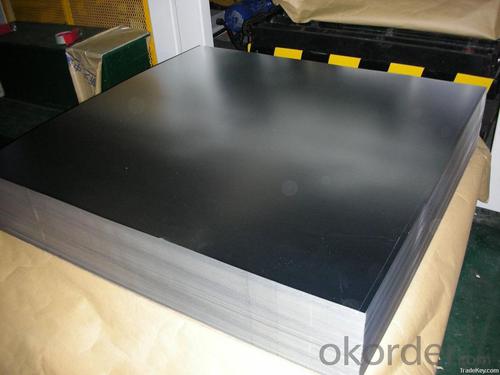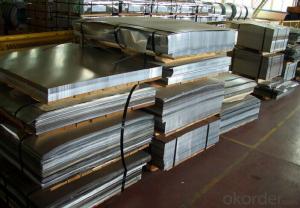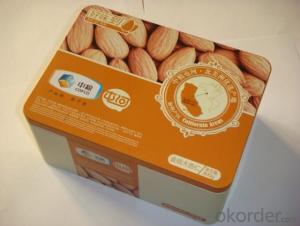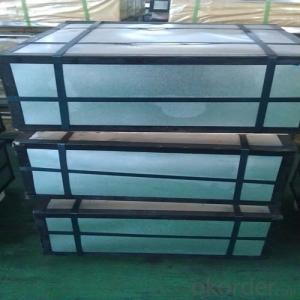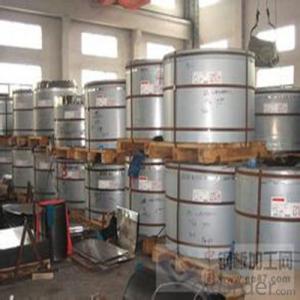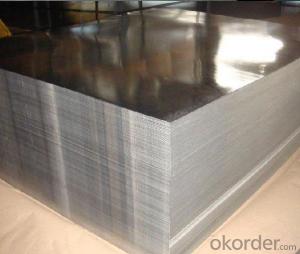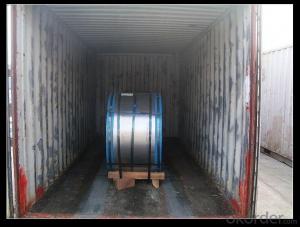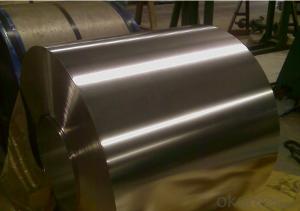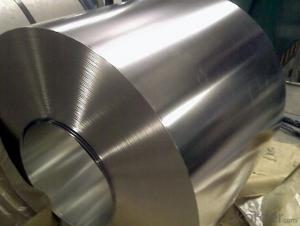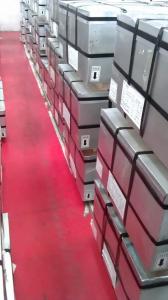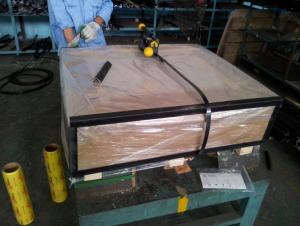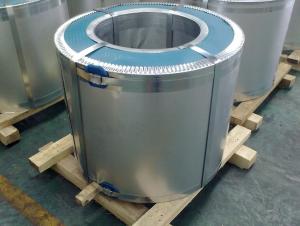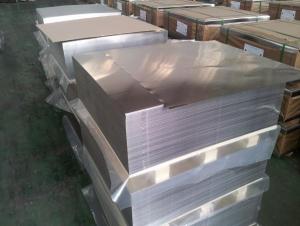Electrolytic Tinplate Coils/Sheets for Foods Packaging
- Loading Port:
- Tianjin
- Payment Terms:
- TT OR LC
- Min Order Qty:
- 25 m.t
- Supply Capability:
- 7000 m.t/month
OKorder Service Pledge
OKorder Financial Service
You Might Also Like
1.Structure of Electrolytic Tin Plate Coils and Sheets for Foods Metal Packaging Description
Electrolytic Tin Plate Coils and Sheets for Foods Metal Packaging, is one thin steel sheet with a coating of tin applied by electrolytic deposition. Tinplate made by this process is essentially a sandwich in which the central core is strip steel. This core is cleaned in a pickling solution and then fed through tanks containing electrolyte, where tin is deposited on both sides. As the strip passes between high-frequency electric induction coils, it is heated so that the tin coating melts and flows to form a lustrous coat.
2.Main Features of the Electrolytic Tin Plate Coils and Sheets for Foods Metal Packaging
Appearance – Electrolytic Tin Plate is characterized by its beautiful metallic luster. Products with various kinds of surface roughness are produced by selecting the surface finish of the substrate steel sheet.
Paintability and printability – Electrolytic Tin Plates have excellent paintability and printability. Printing is beautifully finished using various lacquers and inks.
Formability and strength – Electrolytic Tin Plates have got very good formability and strength. By selecting a proper temper grade, appropriate formability is obtained for different applications as well as the required strength after forming.
Corrosion resistance – Tinplate has got good corrosion resistance. By selecting a proper coating weight, appropriate corrosion resistance is obtained against container contents. Coated items should meet 24 hour 5 % salt spray requirement.
Solderability and weldability – Electrolytic Tin Plates can be joined both by soldering or welding. These properties of tinplate are used for making various types of cans.
Hygienic – Tin coating provides good and non toxic barrier properties to protect food products from impurities, bacteria, moisture, light and odours.
Safe – Tinplate being low weight and high strength makes food cans easy to ship and transport.
Eco friendly – Tinplate offers 100 % recyclability.
Tin is not good for low temperature applications since it changes structure and loses adhesion when exposed to temperatures below – 40 deg C.
3.Electrolytic Tin Plate Coils and Sheets for Foods Metal Packaging Images
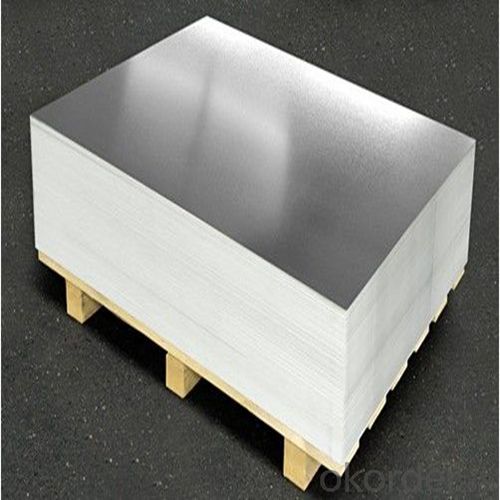
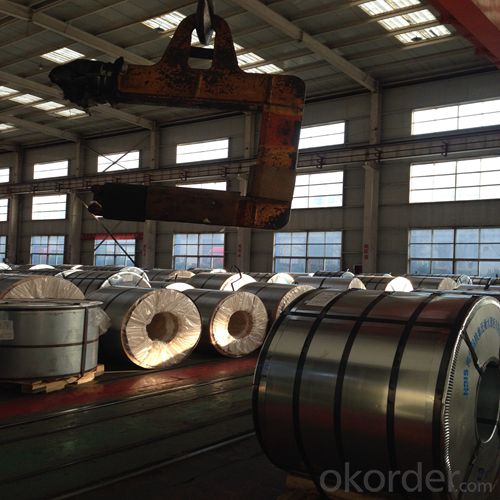
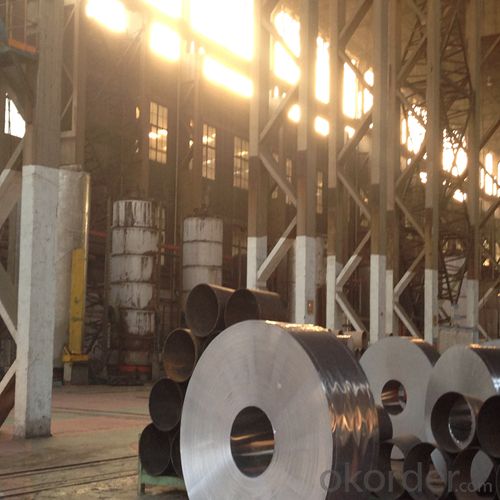
4.Electrolytic Tin Plate Coils and Sheets for Foods Metal Packaging Specification
Standard | ISO 11949 -1995, GB/T2520-2000,JIS G3303,ASTM A623, BS EN 10202
|
Material | MR,SPCC |
Thickness | 0.15mm - 0.50mm |
Width | 600mm -1150mm |
Temper | T1-T5 |
Annealing | BA & CA |
Coil Inner Diameter | 508mm |
Weight | 6-10 tons/coil 1~1.7 tons/sheets bundle |
Passivation | 311 |
Oil | DOS |
Surface | Finish,bright,stone,matte,silver |
5.FAQ of Electrolytic Tin Plate Coils and Sheets for Foods Metal Packaging
- How are the Electrolytic Tin Plates specified?
The Electrolytic Tin Plates are specified as per the steel base, extent of tempering, the coating weight, annealing method and the surface finish.
- How many types there are for base steels?
The base steels are of three types: Type MR, L, D
-What your tinplate material is used for ?
Tinplate is widely used for the packaging of products. Such as food cans,
beverage cans, pet cans, closures, general line cans and so on.
Printed Tinplate is offered!!
-How to place .an order or contact you ?
Please send us Email. we will give you a quick response in seconds .
- How is your quality ?
All our quality is prime even the secondary quality . We have many years experience
In this field with serious quality control standard . Advanced equipment, We welcome your visit to our factory .
- Q: What are the typical dimensions of tinplate sheets?
- The typical dimensions of tinplate sheets can vary, but they are commonly available in sizes of 2.5 feet by 3.5 feet or 4 feet by 8 feet.
- Q: What are the common storage and handling requirements for tinplate?
- Common storage and handling requirements for tinplate include storing it in a dry and well-ventilated area, away from moisture and direct sunlight. It should be kept in a temperature-controlled environment to prevent any damage or corrosion. Proper handling techniques, such as using gloves and avoiding sharp objects, should be followed to prevent any surface scratches or dents. Tinplate should also be stacked and stored in a way that prevents any deformation or structural damage.
- Q: What are the main applications of tinplate in the agricultural industry?
- Tinplate is commonly used in the agricultural industry for various applications such as packaging for seeds, fertilizers, and pesticides. It provides a durable, corrosion-resistant, and tamper-proof solution that helps protect these products from external elements. Additionally, tinplate is also utilized for manufacturing agricultural equipment, containers, and storage tanks due to its strength and resistance to rust.
- Q: How does tinplate contribute to the reduction of food waste?
- Tinplate contributes to the reduction of food waste by providing a durable and protective packaging solution for various food products. Its corrosion-resistant properties and airtight seal help to maintain the freshness and extend the shelf life of food items. This ensures that less food goes to waste due to spoilage or contamination, ultimately aiding in the reduction of food waste.
- Q: How can tinplate be rustproof? Products must not be oil
- RP014C-23A thin layer quick drying antirust oil is made up of film forming agent, oil soluble corrosion inhibitor and refined petroleum solvent. It is a kind of volatile long-term antirust oil.
- Q: How does tinplate packaging contribute to product protection against light?
- Tinplate packaging contributes to product protection against light by providing a durable and opaque barrier. Its metallic properties prevent light from penetrating through the packaging, thus minimizing exposure to UV rays and other forms of light that can degrade the quality and shelf life of sensitive products.
- Q: What are the main components of tinplate?
- The main components of tinplate are steel and a thin layer of tin coating.
- Q: How does tinplate contribute to the shelf life of canned products?
- Tinplate contributes to the shelf life of canned products by providing a protective barrier between the food and the metal can. This barrier prevents the food from coming into direct contact with the metal, reducing the risk of corrosion and contamination. Additionally, tinplate's resistance to moisture and oxygen helps to maintain the product's freshness and prevent spoilage over an extended period of time.
- Q: What are the different closure mechanisms for tinplate cans?
- The different closure mechanisms for tinplate cans include: slip cover lids, press-on lids, pull-tab lids, twist-off lids, and peel-off lids.
- Q: How does tinplate affect the sound quality of musical instruments?
- Tinplate can have a significant impact on the sound quality of musical instruments. Due to its unique properties, such as being lightweight and having good resonance, tinplate is often used to construct various components of musical instruments, particularly in brass instruments like trumpets and trombones. The use of tinplate can enhance the instrument's tonal characteristics, producing a brighter and more vibrant sound. Additionally, tinplate's smooth surface can contribute to improved airflow and response, allowing musicians to achieve better control and projection. Overall, tinplate plays a crucial role in shaping the sound quality and performance of musical instruments.
Send your message to us
Electrolytic Tinplate Coils/Sheets for Foods Packaging
- Loading Port:
- Tianjin
- Payment Terms:
- TT OR LC
- Min Order Qty:
- 25 m.t
- Supply Capability:
- 7000 m.t/month
OKorder Service Pledge
OKorder Financial Service
Similar products
Hot products
Hot Searches
Related keywords
